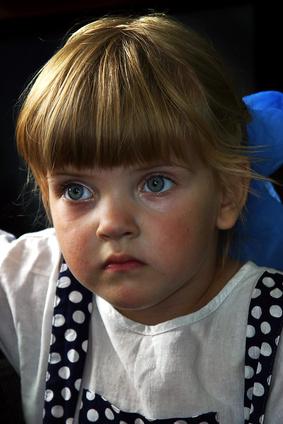A certain amount of child anxiety and fear is normal, even helpful. Anxiety about strangers or a fear of fire can help small children stay out of harm’s way. When anxieties and fears persist to a point that interferes with a child’s daily life, this can be problematic. An anxiety about strangers that persists can lead to social isolation when a child gets older. Your job as a parent is to help your child move beyond his anxieties and fears.
Signs to Look For
An anxious or fearful child may display certain signs, according to the Kids Health website. Clinginess, impulsive behavior and distractedness are all indicators of fear or anxiety. Some children develop twitches or tics, have problems going to sleep or staying asleep, or have sweaty hands, an accelerated heart or breathing rate, nausea, or headaches. Sometimes all it takes to alleviate some of this anxiety is to listen and talk to your child.
Typical or Problematic
It’s sometimes difficult to know whether your child is experiencing typical childhood fears or whether you should become concerned. Kids Heath gives some guidelines. For example, if your young child is afraid of the dark, that is a common fear that most kids outgrow. You shouldn’t be alarmed about that. But, if your child does not outgrow the fear or if she becomes anxious about an increasing number of things, that may signal a problem. If an anxiety is a one-time occurrence, don’t make a bigger deal out of it than it is. However, if you see a pattern of anxiety or fear, you should contact your doctor or a mental health professional, according to the Kids Health website.
Significance
It is important that you deal with anxiety disorders in your child because many adults who have psychiatric problems started developing them in childhood, according to the Keep Kids Healthy website. This website points out that anxiety disorders are the No. 1 health problem in the United States. No statistics exist as to how many children have anxiety disorders, but a consensus among doctors is that they are underreported in children.
Types of Therapy
If you decide to seek professional help for your child, cognitive behavioral therapy is a common treatment. This therapy seeks to stop the automatic fearful response and teaches specific techniques to replace the fear. Treatment can also include psychotherapy to resolve conflicts through talk therapy and behavioral therapy, which teaches relaxation techniques and desensitization.
Causes
Children can develop anxieties and fears for many reasons. It could be a learned response to a past experience, a genetic reason, a biologic reason or a medical reason. Because of the array of causes, it is best to have a doctor’s diagnosis.





